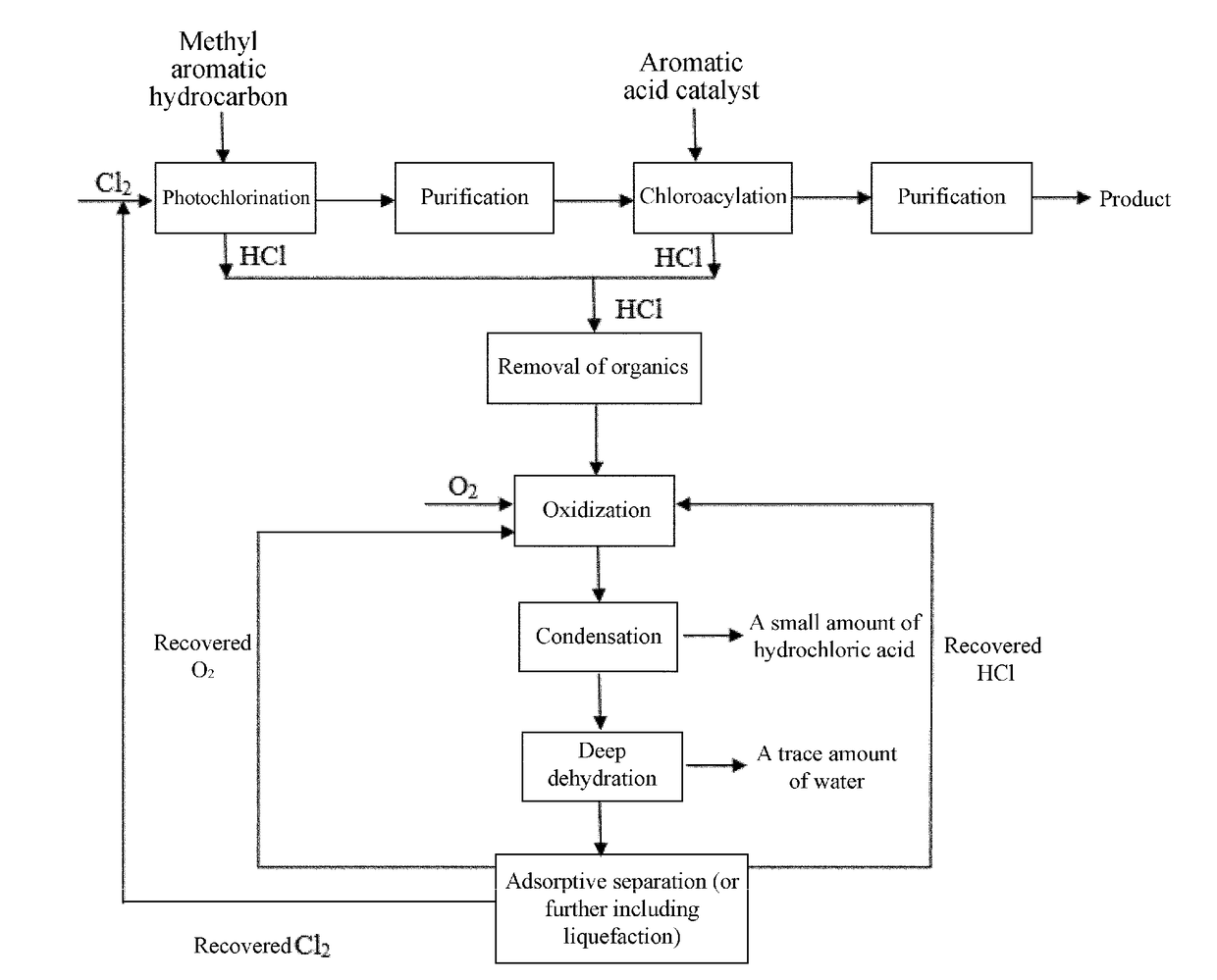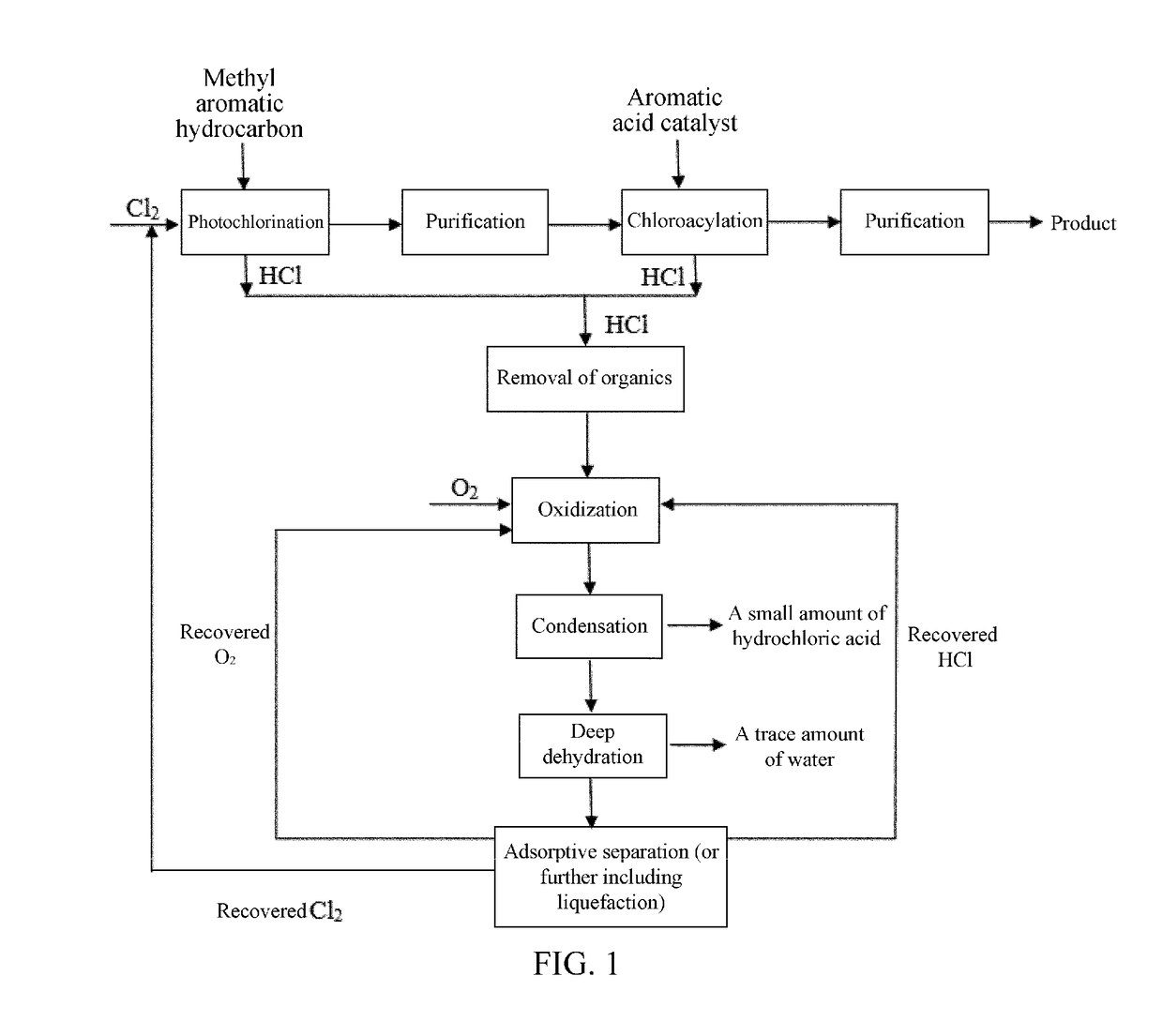Clean process for preparing chloroformyl-substituted benzene
a chloroformyl and benzene technology, applied in the field of chloroformylsubstituted benzene preparation, can solve the problems of environmental pollution, high cost, inconvenience to subsequent, etc., and achieve the effects of reducing environmental pollution, reducing production cost, and prolonging catalyst li
- Summary
- Abstract
- Description
- Claims
- Application Information
AI Technical Summary
Benefits of technology
Problems solved by technology
Method used
Image
Examples
example 1
[0125]As shown in FIG. 1, step 1, the chlorination reaction, is carried out as follows. In a continuous photochlorination apparatus consisting of 3 reaction columns connected in series, 1,3-dimethylbenzene is continuously added at a rate of 95 kg / h from the top of the first column, where the first column is controlled at a temperature of 80° C-120° C., with a central peak wavelength of incident light of 460 nm and an average illuminance of 20000-39000 Lux, while chlorine gas is fed at a flow rate of 135 kg / h from the bottom for continuous chlorination reaction. The reaction solution in the first column overflows from the bottom into the second column, where the second column has central peak wavelength of incident light of 505 nm and an average illuminance of 40000-61000 Lux. The second column is controlled at a temperature of 135-145° C., and chlorine gas is fed at a flow rate of 128 kg / h into the second column. The reaction solution in the second column overflows from the bottom i...
example 2
[0137]The specific operation process is described below.
[0138]Step 1, chlorination reaction
[0139]The operation process of the chlorination reaction is the same as step 1 in Example 1. The differences are that, 1,4-dimethylbenzene is used, the rate entering the first column is 100 kg / h, and the first column has a central peak wavelength of incident light of 460 nm and an average illuminance of 20000-39000 Lux; the second column has a central peak wavelength of incident light of 505 nm and an average illuminance of 40000-61000 Lux, and the second column is controlled at a temperature of 135-145° C.; and the third column has a central peak wavelength of incident light of 586 nm and an average illuminance of 60000-86000 Lux, and the third column is controlled at a temperature of 170-180° C. The resulting reaction mixture at the outlet of the third column is 1,4-bis-(trichloromethyl)-benzene, which is purified by single rectification to obtain purified 1,4-bis-(trichloromethyl)-benzene. ...
example 3
[0150]The operation is similar to the specific steps in Example 2, except the raw material methyl aromatic hydrocarbon is p-chlorotoluene, which is reacted with chlorine gas to obtain p-chloro-(trichloromethyl)benzene. The corresponding aromatic acid is p-chlorobenzoic acid.
PUM
| Property | Measurement | Unit |
|---|---|---|
| wavelength | aaaaa | aaaaa |
| wavelength | aaaaa | aaaaa |
| temperature | aaaaa | aaaaa |
Abstract
Description
Claims
Application Information
 Login to View More
Login to View More - R&D
- Intellectual Property
- Life Sciences
- Materials
- Tech Scout
- Unparalleled Data Quality
- Higher Quality Content
- 60% Fewer Hallucinations
Browse by: Latest US Patents, China's latest patents, Technical Efficacy Thesaurus, Application Domain, Technology Topic, Popular Technical Reports.
© 2025 PatSnap. All rights reserved.Legal|Privacy policy|Modern Slavery Act Transparency Statement|Sitemap|About US| Contact US: help@patsnap.com


